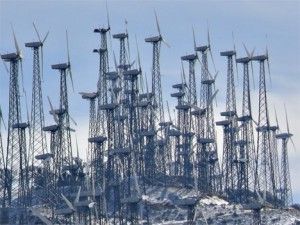Markets ‘Crush’ Brown's Windmill Fantasy
By WAYNE LUSVARDI
With the swagger of a boxer before a match, on July 24 Gov. Jerry Brown said he would “crush” any efforts to block renewable energy projects in California.
Brown apparently was referring to efforts by environmentalists to stop a planned gargantuan 968 Megawatt solar energy project called Solar Millennium to be located in the Mojave Desert. This is a pet project of President Obama and is backed by a $2.1 billion federal loan guarantee to build the first half of the project.
With Brown’s use of his bully pulpit and the threat of legal action against any opposition to large solar power plants in the Mojave Desert and elsewhere, what are Californians left to conclude — so much for the natural environment, the rule of law and democracy?
But markets will eventually crush renewable energy if it is ever exposed to an open and competitive energy market instead of the government-protected and heavily subsidized energy “market” in California.
And the bond market may eventually react to Brown’s 2011-12 state budget gimmickry. The bond market could impose a higher interest rate premium for the greater risk of default of state general obligation and revenue bonds. Or the higher cost could come from greater risk of default in providing sufficient funds to meet mandated state services such as Medi-Cal and K-12 public education.
Moreover, the Government Accounting Standards Board (GASB) has just issued rules that require public pension funds to “mark-to-market” the amount of unfunded pension liabilities of CalPERS, CalSTRS and other public pension funds in California. This rule change will finally reveal that CalPERS is only perhaps 50 percent funded, instead of 70 percent funded as it claims.
Let’s take a quick look at the scorecard of how Jerry Brown has fared with markets in relation to environmental-energy issues in his three terms as governor of California.
Bottle Rock Geothermal Plant Failure
When Brown formerly was governor in the mid-1970s, the state Legislature approved whopping 55 percent tax credit for wind, solar and biomass energy plants. President Jimmy Carter signed a 1978 federal law called the Public Utility Regulatory Policies Act (PURPA). It encouraged states to enact their own green-power tax incentives and helped launch renewable energy. Brown claims he pioneered tax credits for renewable energy in California.
In July of 1979, the state Department of Water Resources filed an application for construction of two geothermal energy plants in Northern California, the Bottle Rock and South Geysers Geothermal Plants, to carry out Brown’s plans for an environmental legacy. The Bottle Rock Plant was finally built in 1985, after Brown left office in 1983. To make a long story short, by 1990 the Bottle Rock Geothermal Plant was shut down because it couldn’t generate enough electricity to pay off the revenue bonds that financed the construction of the plant. The South Geysers Plant was never built. State government should never have built the plant, as it was financially infeasible in the market from the get-go.
In December 1990, the Metropolitan Water District of Southern California ended up having to pay off the $283 million in bonded indebtedness on the plants. The bonds won’t be paid off until 2024. So Southern California water ratepayers ended up having to pay off the bonds on a Northern California power plant that has since been re-opened and now ironically generates power exclusively for Northern California cities.
Strike one against Brown.
Score: Markets 1. Brown 0.
Abandoned Wind Farms in Town of Mojave
To make another long story short, by 1998 ugly old wind machines in the Tehachapi Gorge near the desert town of Mojave in Kern County were abandoned in place. The reason: dropping natural gas prices made over-market-priced wind energy uncompetitive. To view the photographs of the visual blight and nuisance of the abandoned wind farms, go to this link.
The tax credits under PURPA ended up a tax scam as wind developers just collected their credits and abandoned the wind turbines without restoring the land to its original condition.
Most counties and cities now require the removal of unsightly wind turbines if wind farm operations are ever shut down. But the sheer size of the proposed solar project near the Blythe would raise questions of who would remove the solar mirrors if the project went bankrupt? Without a costly demolition bond paid up front, who would pay for such removal of 11 square miles of mirrors? This has probably crossed the minds of those in Riverside County where the Blythe Solar Project — referred to by Gov. Brown and encompassing some 7,000-acres — is to be developed.
This does not even consider that solar thermal-power technology, as planned at the Solar Millennium Project in Blythe, is typically 4.7 times the price of low-polluting natural gas power, 3.6 times the price of clean hydropower and 2.2 times the average retail price of electricity for residential use in California in 2011 (see table below).
Comparative Price of Energy
| Energy Source | Price per Kilowatt Hour in Dollars and Cents | Price Difference as a Multiple Compared to NatGas |
| Natural gas | $0.066 | Baseline |
| Hydroelectric power | $0.086 | 1.3 x |
| Conventional coal | $0.095 | 1.4 x |
| Wind | $0.097 | 1.47 x |
| Geothermal power | $1.02 | 1.5 x |
| Nuclear power | $1.04 | 1.57 x |
| Average price California Residential Electricity 2010 | $1.48 | 2.2 x |
| Photovoltaic power | $2.11 | 3.2 x |
| Solar thermal power | $3.12 | 4.7 x |
| Sources: http://www.eia.gov/cneaf/electricity/epm/table5_6_a.html http://reason.com/archives/2011/05/10/environmentalists-were-for-fr |
||
.
Not only is solar thermal power way over the market price of every other source of power. It doesn’t even reduce pollution because it is located in the remote desert instead of in an urban-air basin that traps smog.
So Brown lost again.
Score: Markets 2. Brown 0.
The Energy Crisis of 2001
PURPA allowed non-public energy producers to sell electricity to utilities for the first time. PURPA led to the accounting schemes of Enron. Enron did not cause the California Energy Crisis of 2001. But PURPA did lead to the notion that energy deregulation might be able to pay off the bonds on old polluting power plants. The plants had to be mothballed to meet stricter EPA air quality standards in California in 2001, or risk forfeiting federal highway, education, and Medicaid funding.
Energy deregulation failed in California because a heavily Democratic majority ih the state Legislature and Democratic Gov. Gray Davis pulled the plug on it. But electricity deregulation may have failed anyway as long as it was based on PURPA tax credit schemes instead of market price competition.
But the California Democrats’ own plan to contrive a pricing fever — or bubble — to pay off the bonds on the old polluting power plants also failed. The result: rolling blackouts, the 2003 recall of Gov. Gray Davis and the rolling of the bond debt on mothballed dirty power plants into a $42 billion general-obligation bond that will be paid off in 2012.
When the $42 billion in bonds are paid off next year, the long-term energy contracts that paid off those bonds will come under SB 2, which Brown signed on April 12. SB 2 mandates that one-third of California’s electricity must come from renewable sources by 2020.
The Energy Crisis of 2001 morphed into 33 percent permanently over-market-priced Green Power to begin in 2012.
So Brown lost for a third time.
Score: Markets 3. Brown 0. Three strikes and he’s out.
Three Strikes, You’re Out — Except in Politics
In baseball, three strikes and you are out. In California politics, three policy failures and you are enshrined as the guru of renewable energy. California Gov. Jerry Brown has repeatedly failed each time an environmental project or policy of his has been exposed to the market.
Brown vows to “crush” any opposition to the gigantic Millennium Solar Project in the remote Mohave Desert. But NIMBY’s — Not-In-My-Back-Yarders — are not very concerned about huge solar projects that may harm the desert ecology as long as it doesn’t affect their home values or beautiful mountain views.
What Brown likely will end up crushing is the middle class that will eventually be sandwiched between higher energy prices and mass unemployment.
Related Articles
CA expands health entitlements
As California included some unlawful immigrants in Medi-Cal, its version of the Medicaid program, a new study suggested that, nationwide, that
Lawmakers embark on high-speed journey through Japan
As California moves forward with the state’s first high-speed rail system, questions remain about the viability of the $68 billion transportation
Anti-UFW farm workers seek help from Gov. Jerry Brown
SACRAMENTO — Roll over, Cesar Chavez, here comes Silvia Lopez. custom essay writing services Silvia Lopez is a quiet, thoughtful





